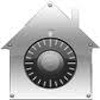One reason given by many for why they switched to Mac OS X is that it’s virus-free and doesn’t need extensive security measures. While this is partly true and you’ll likely find yourself at significantly lower risk for infections than you would with a Windows machine, it’s also partly a myth because Mac OS X can get viruses. For example, there was a security scare earlier this year with Mac OS X Trojan Flashback.
Be sure to keep your computer secure! Here are some tips and tricks you need to know about in order to make sure your computer is safe.

1. Update your Mac when it asks you to do so.
When viruses like the Trojan Flashback spread, Apple releases software updates that help detect and eliminate these threats. If prevention doesn’t work, you can at least find a cure through the software updates as long as you install them promptly. Many such viruses take advantage of loopholes in security updates or infrequent program updates, so making sure your software is up-to-date will protect you. To check for software updates, click the apple icon in the top left corner, then “Software Update…” and wait for the computer to detect whether you are behind on updates or not. It will take only a few minutes and will save enormous trouble!
2. Use strong passwords.
This is a good practice for computer and internet use in general, as it prevents you from losing data and information, or even your identity, to thieves. It’s a good idea if you want to keep your Mac physically secure when you work in different places or carry around your laptop, and if your laptop gets stolen, it will protect your data.
A strong password isn’t hard to generate. Think of a phrase that means something to you. A phrase as simple as “My daughter’s birthday was October 18th, 1999!” could be turned into the password, “MdbwO18th1999!” with several capitals, numbers, and an exclamation mark – far more secure than a password like “password” (which is one of the easiest to guess and quickest to break into).
3. Turn off automatic login.
If you’re carrying your computer around, you really shouldn’t have it set to log you in automatically. If your computer is stolen while it’s off, a thief can easily boot up your computer and access all your private information, from banking statements to email account passwords.
As quickly as that, your life will be chaos and it will take months to undo this damage. Some computer viruses take advantage of this, too, by logging into the main user’s account without your permission to access and change files. Even if your password is weak, it’s better than having no password at all protecting your valuable data.
4. Use an anti-virus program.
Just because you’re not on Windows doesn’t mean you can skip anti-virus software. A free application like ClamXav or a paid one will do the job nicely, as long as you use it regularly and don’t get complacent about opening new files simply because you have an anti-virus program. It’s just another line of defense that can help you out.
5. Stop file sharing and remote login.
Go to System Preferences, select Sharing, and disable file sharing or change permissions for Everyone to No Access so that you won’t have random strangers able to access your files when you connect to public wi-fi or if they break into your network.
Remote Login, Bluetooth Sharing, and other types of remote sharing are also good candidates to disable unless you regularly use them; even if you do use them regularly, make sure you adjust their settings so people have to log in first (password-free screen sharing should never be enabled, for instance).
6. Use your common sense.
The most important step in keeping your Mac secure is to use common sense when confronted with unusual computer situations. If your computer is asking you to install something and you didn’t just download anything knowingly, deny the request and search on Google for the program name.
If you’re browsing file-sharing sites, scan files you download before you open them. If a contact you rarely hear from sends you a link out of the blue that says something like “look at the pics of you here!” or “is this really you?”, it’s probably trying to trick you into clicking. Search before you click, and use appropriate caution as you surf.
Keeping your Mac secure is easier if you follow these steps, and you’ll ensure that you don’t end up struggling with a frustrating mess of a hard drive. You’re not completely safe from trojans and other viruses, but these steps will help.


